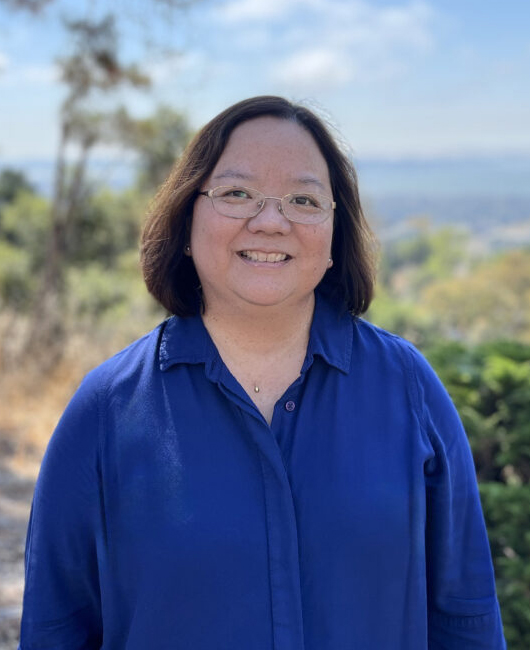 “I feel seen,” Lori Tamura said when she received the 2023 Renner Award. “That expression really resonates with me. My work isn’t going out into the void—it’s actually seen and appreciated.”
“I feel seen,” Lori Tamura said when she received the 2023 Renner Award. “That expression really resonates with me. My work isn’t going out into the void—it’s actually seen and appreciated.”
As the ALS science writer, Tamura has a deep understanding of expressions that resonate. She creates them. For 25 years, she has been responsible for bringing ALS science to a broader audience.
In celebration of her work, the ALS Users’ Executive Committee presented Tamura with the 2023 Tim Renner User Services Award “for her exceptional work communicating the scientific achievements conducted at the ALS to the general public through her writing.” Beamline scientists and users alike have worked with Tamura and are quick to praise her skill in highlighting their research.
Tamura writes longer-form science highlights and shorter-form briefs based on publications from ALS work, as well as feature articles. With 40 beamlines, 1,700 users per year, and 16,000 publications since 1993, the abundant source material must first be pared down by a highlight selection committee. In a meeting where ALS staff representing a multitude of research areas and techniques all champion the publications they believe best illustrate ALS impact, Tamura has the difficult task of tracking and facilitating all the input until the group reaches a consensus.
“She leads science selection meetings with empathy, offers valuable insights, and willingly supports other colleagues in their decision making,” said ALS Staff Scientist Slavo Nemsak. He also lauded Tamura’s “unwavering commitment to communicating science effectively to diverse audiences” in describing the extent of her service to users.
To communicate science effectively, Tamura works closely with coauthors of the publications she highlights. “The users have been uniformly great,” she said. “I’m asking people to do extra work on their end, and the reply is usually yes.” Their willingness to entrust their scientific stories with Tamura stems from the care she takes in explaining their work.
Francesca Toma, director of the Institute of Functional Materials for Sustainability at Helmholtz Zentrum Hereon, described the balance that Tamura achieves. “Without sacrificing the accessibility of her writing, the scientific details of the work are accurately reported.” Many other ALS users share her confidence in Tamura.
Pupa Gilbert, professor at the University of Wisconsin–Madison, explained why she trusts Tamura. “She is able to perceive the key point of every experiment.” Not only does Tamura glean important details from papers and by interviewing authors, her interpretation allows even more people to understand the work. Gilbert described how Tamura’s articles have spread beyond scientific circles. “Her writing is most effective at communicating the significance of my group’s research to Congress representatives and their constituents.” Gilbert added, “Lori is a great videographer too! She recorded, edited, and published a video on saving coral reef ecosystems that I submitted to the 2026 NSF Idea Machine competition.” From the written word to moving images, social media posts to feature articles, Tamura incorporates a multitude of techniques to increase the impact and reach of results from the ALS.
Tamura’s curiosity for science and aptitude for writing are both long-standing interests, dating back to her undergraduate days when she considered double majoring in physics and English. Her advisor made appointments for Tamura to meet with each department chair, and by happenstance, the physics meeting came first. “He told me physicists have to write, so I majored in physics, but it was always in my mind that I would write about science.”
Her goal of science writing led Tamura to move from Hawaii, where she’d grown up, to Rensselaer Polytechnic Institute in New York for a master’s degree in technical communication. Through an internship and a subsequent permanent position, she wound up in California, fulfilling another goal—that of living on the west coast.
“Growing up in Hawaii, you feel like a small fish in a small pond, and I wanted to get out there and see how far I could go,” Tamura explained. “When I went to the east coast, I felt like a fish out of water. California feels like home.”
Over the course of her career, Tamura’s writing process has evolved from the early days of melting wax to literally cut and paste text passages and poring through the physical pages of a scientific and technical dictionary. What has not changed is a fundamental step: “Do your homework,” Tamura said. After reading a paper and asking questions of the researchers, she allows the information to percolate until she can identify the key information for her audience. To show them why the results matter and how the ALS contributed, she mulls over what the audience already knows and what they don’t know before writing about it in the clearest language possible. Through her thoughtful interpretation, Tamura has made complex concepts more approachable and accessible.
Characteristically reluctant to brag, Tamura quickly turns discussion of her award back to others. “I would be remiss if I didn’t thank the beamline scientists and the users,” she said. “Without them, I wouldn’t be able to have had my dream job for 25 years.”
Tim Renner was a beamline scientist at the ALS whose battle with cancer cut short a career distinguished by a caring attitude and larger-than-life personality. This award recognizes the services of people across the ALS organization who have made outstanding contributions to the ALS user community.